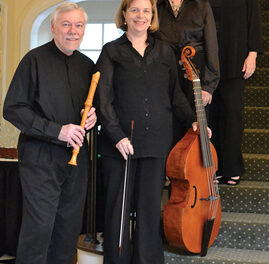’round midnight: Henri Dutilleux (1916-2013), Ainsi la nuit, Raphaël Merlin (b. 1982), Night Bridge, Arnold Schoenberg (1874-1951), Verklärte Nacht, Op. 4; Quatuor Ébène, Pierre Colombet, violin, Gabriel Le Magadure, violin, Marie Chilemme, viola, Raphaël Merlin, cello, joined by Antoine Tamestit, viola, and Nicolas Altstaedt, cello for the two sextets (sextuors); Erato 019026641909, © 2021, TT 69:51; $16.50 (Presto Music).
You likely noticed that Ébène’s cellist is the composer of the middle work; its title is apt, as the works are performed in alphabetical, not chronological order. All are multi-movement pieces, with 12, 11, and 8 movements respectively. Merlin also wrote the program notes in the 28-page accompanying booklet, a somewhat poetic six-year narrative (they performed the two existing pieces, along with other related ones, in total darkness on a tour!) entitled Nuits. There is also a very good British English translation by Robert Sargant, Nights, which naturally comes off a bit less poetic; it improves comprehension if one can read both languages. Merlin’s writing runs through the catalogue of works by other composers on the subject of night, making connections between sound and color (see my article on this subject), and he concludes with the story behind his new composition.
As Schoenberg was inspired by Richard Dehmel‘s poem titled “Verklärte Nacht,” Night Bridge was inspired by several jazz classics that treated the subject: “Moon River,” “Night and Day,” “Stella by Starlight,” and “‘Round Midnight.” The resulting music turned out to be a very American bridge, “in flavour for sure,” “which would allow us to link the two aforementioned masterpieces, like a vast nocturnal fresco,” borrowing Dutilleux’ structure and working in “previously heard material” as well as “the most striking and persistent elements of his harmonic language, while also attempting to capture something of the power of the post-Romantic spirit that pervades” the Schoenberg, “just before he ‘flipped into atonality’,” to progress from quartet to sextet (pp. 8 & 14). Cole Porter’s “Night and Day,” from the musical Gay Divorce, and two movies were also involved in the process: Pedro Almodóvar’s Hable con ella, and Blake Edward’s Breakfast at Tiffany’s. All of these songs, whose histories are carefully recounted, are likely much better known from renderings by others. Merlin’s series culminates with Thelonious Monk’s “Round Midnight,” and ends at sunrise, quoting Ravel’s Daphnis et Chloë and evoking chirping birds. To my ears, it’s a resounding success. Quatuor Ébène tried it out once in a live performance and it survived; they are leaving its success in its first recording up to the listeners.
The compositional process of Night Bridge seems ultimately collaborative and communal, and I am inclined to believe that it involved some improvisation as well as imitation. Improvisation is becoming somewhat more common again in classical music (only in organ recitals has it remained without interruption). It was dominant in the Baroque and Classical periods when it was promoted and taught. Early Music America recently published (digitally, available for download) an article by John Mortensen, professor of piano at Cedarville University in Ohio: “Going Off Script: Modern Pianists Turn to Early Music to Learn Improvisation.” Improvisation is very much alive in the jazz world but has become verboten in the classical one over the past 150 years. Earlier musicians, including composers like Chopin and Liszt, were taught to improvise; this was the source of all the latter’s fantasias, as it was of Bach’s and Beethoven’s: the career of a musician in the 18th century required the skill of improvisation.
The basis of improvisation is partimento; the bass line determines the harmonizing upper lines, moving between dissonance and consonance as taught in the 18th century Italian conservatories, to the children in Italian orphanages, and spread throughout Europe. Several treatises for this survive; they contain patterns based on the Rule of the Octave. In the Italian conservatories, students learned cadences and modulations first and progressed to movimenti del partimento, or movements up and down. This led to counterpoint, with standard conventions such as canon and inversion. All of this was taught at the keyboard and led to the easy execution of improvisation.
Interest in improvisation is being revived: Mortensen’s book, The Pianist’s Guide to Historic Improvisation, was published by Oxford University Press in May 2020, there’s an online school for improvisation (Improv Planet), and an international convention is planned in Denmark. Harpsichordist Ewald Demeyere creates YouTube demonstrations of partimento realizations that anyone can watch; listeners as well as musicians can easily learn about the style. Many musicians are tiring of performing only a small number of works when millions more are out there, and many audience members are tired of hearing the same ones over and over. The renewed art of improvisation may well help entice the general public to return to classical music as the public showed up for the genre “in the olden days.”
Even if you have favorite recordings of the Schoenberg and Dutilleux, you should add this one to your collection. It’s the only one on the market that has both, not to mention the value of the presence of the custom-made Merlin Bridge, whose subtitle is: “nocturnal poem for string sextet after four jazz standards on nighttime to link Ainsi la nuit and Verklärte Nacht.” The performances are really outstanding!











